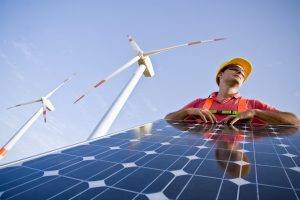
President-elect Trump’s victory tour began in Indiana last week, where he and running mate Mike Pence announced they had cobbled together enough taxpayer cash to convince Carrier – a gas furnace manufacturer that planned to move 2,000 jobs to Mexico – to keep some of its jobs in the state.
But just two years ago, Governor Pence allowed Indiana to become the first state to abandon its energy efficiency standards – a move that Carrier and other companies warned would threaten nearly 1,500 jobs and $500 million a year in local economic investment. Evidently, losing 1,500 jobs wasn’t enough to worry about. Yet two years and a presidential election later, saving 1,000 on the backs of taxpayers is held up as proof that Trump is making good on his promise to reinvigorate the American economy.
Politics is theatre, but what worries me about the Carrier announcement is that it underscores how our new president and vice president don’t understand the true economic potential of clean, modern energy.
The clean energy industry – everything from wind turbines and solar panels, to home energy storage and energy efficiency – is exploding around the country. In 2014, the U.S. clean energy market grew by 14 percent – at nearly five times the rate of the overall economy – to nearly $200 billion. That’s bigger than the U.S. airline industry, and roughly equal to the pharmaceutical business. And this growth is creating millions of quality, homegrown jobs. If Trump wants to be the jobs president he promised he would be, someone needs to brief him on the facts.
There are more American jobs in solar energy today than in coal mining and oil and gas extraction. And the number of solar jobs in the U.S. has grown more than 20 percent in each of the last three years.
Wind energy is also a huge employer of Americans – especially in low-income and rural communities. American wind power supported a record 88,000 jobs at the start of 2016, and 70 percent of wind farms are located in low-income counties, supplying them with an economic boost. And despite Trump’s false claims that “we don’t make windmills in the United States,” over 60 percent of a modern wind farm’s value is made in America by 21,000 factory workers. Even veterans are benefiting from the wind industry, as wind jobs use many of the transferrable skills veterans have.
[Tweet “What Trump and Pence Don’t Get about Clean Energy Jobs”]
And let’s not forget about energy efficiency, an industry that spans construction, manufacturing, and design. 1.9 million Americans are employed, in whole or in part, by the energy efficiency products and services industry – and almost 1.2 million of these jobs are in construction.
These are well-paying jobs that can’t be shipped overseas. In other words, they’re exactly the kind of jobs that Americans voted for this November. And they’re jobs perfectly suited for manufacturing workers that are pinched by today’s economy.
California provides an excellent case in point. Clean energy jobs there have increased 10 times faster than in other sectors over the past decade. Since 2006, the state has seen investments of $27 billion in clean energy venture capital. California experienced this remarkable growth all while lowering its carbon emissions because it embraced clean energy as an economic opportunity and not a threat.
If you add jobs that improve the efficiency of traditional industries – for example, the engineers that are reducing methane emissions from the oil and gas industry or improving the fuel efficiency of automobiles – the impact of “clean energy” on our economy is even larger.
Clean energy makes good business sense, and America’s biggest businesses are jumping on board. Walmart plans to power half its operations with wind, solar, and other renewables by 2025. Microsoft invested in 237 megawatts of wind energy to power its data centers. Tesla is as much an energy company as it is a car company. Google is investing in renewable energy. Apple is not just a computer company, but a reseller of the excess electricity generated from its solar panels. America, Inc. is betting on clean energy, and for good reason. Renewables offer shelter from the price volatility of fossil fuels, saving companies money and giving them a competitive edge in the long run.
Clean energy is bi-partisan. There is now more wind and solar energy in Republican districts than in Democrat districts.
Clean energy is bi-partisan. There is now more wind and solar energy in Republican districts than in Democrat districts. My home state, Texas, produces more wind power than most countries. Reliable, modern, clean, and local job creation transcends political divides. It’s a great opportunity for a president who America hopes will spur the economy and heal some deep political wounds.
Finally, and maybe most importantly, clean energy is far more popular with voters than fossil fuel energy. According to a recent Pew Poll, huge majorities of Americans say they want more wind (83 percent) and solar (89 percent) – nearly double the number that want more fracking (42 percent) or coal mining (41 percent). Even 75 percent of Trump voters support taking action to accelerate the development and use of clean energy in the United States.
Across the country, in red states and blue, Americans want the next generation of job growth to come from technologies and industries that create local jobs and keep our communities clean and healthy.
If we learned one thing this election, it’s that Donald Trump likes to give people what they want. In that regard, I hope he governs as he campaigned and grabs hold of the clean energy potential right in front of him. It won’t just be good for his legacy, it will be good for our economy, our climate, and our future.
This post originally appeared on Forbes.









